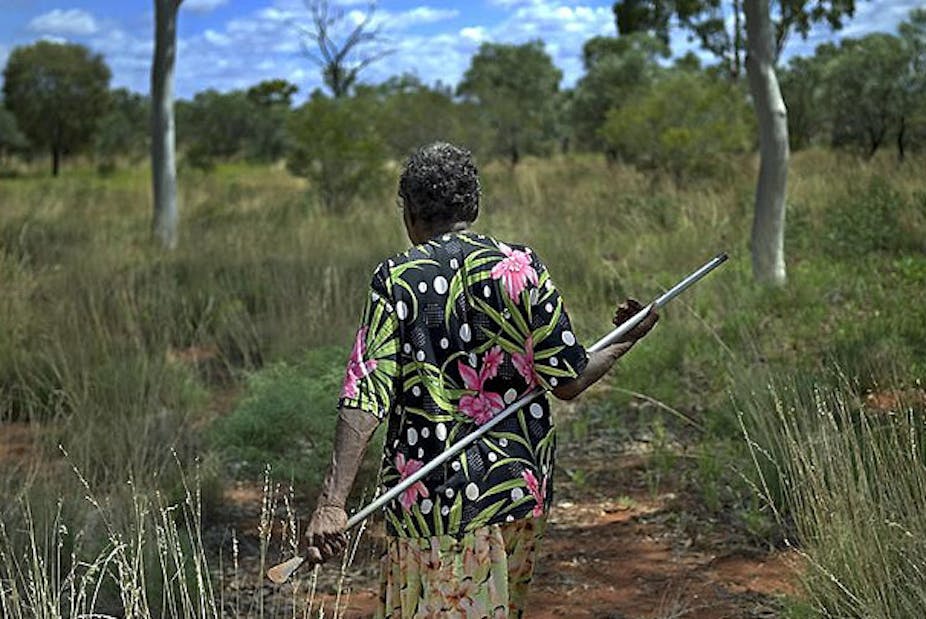Government efforts to “close the gap” between indigenous and white Australians ignore the needs of nearly 1000 homeland communities on the Indigenous estate.
Australian citizens living at the most remote and smallest localities, established with government support in the 1970s and 1980s, are being neglected by Canberra today in favour of bigger hub towns.
The Closing the Gap mantra targets 29 larger and more visible communities only because they are larger and more visible. Economic rationalisation is convinced that size, whether townships or shires, will deliver cost savings from economies of scale.
And so the logic goes that a large school, even if devoid of students, is more cost effective than a number of small schools where attendance might be higher.
Creative destruction
Hub and spoke models have worked well for outstation resource agencies, regional art centres and Community Development Employment Programs over the past four decades. Schooling, health services and the delivery of consumer goods to remote homelands also happened effectively in the 1980s.
Have we become less efficient? Has the loss of national productivity impacted disproportionately on remote Indigenous Australia? Or has there just been diminishing investment in these communities?
We are seeing the creative destruction of community-based organisations that have historically delivered to homelands. This destruction is in the name of Closing the Gap and associated imagined development for those in larger places rather than for all.
Evidence suggests that homelands might be more productive, viable and socially vibrant communities than larger places. This is not to say that all larger places are unproductive, unviable and socially dysfunctional. But that they often face more complicated political challenges than smaller more cohesive places do.
Job creation
It is of deep concern that there is no evidence of any economic growth at Territory Growth Towns, despite the massive investment by National Emergency Intervention programs and National Partnership Agreement multi-year, multi-billion dollar commitments. At least not for most black residents.
A recent report notes that jobs created by the Australian state at townships in the name of proper employment to replace state-subsidised jobs are only deemed sustainable if accompanied by continual state subsidisation. This surely gives sustainability a very new meaning.
It is of grave concern that there is no scenario planning for what is possible or desired (including by the land’s owners) at larger places targeted for growth. Or that inter-connections between larger communities (of which there are about 200) and smaller ones (of which there are about 1000) is neither recognised nor explored in any systematic way.
Australia is obliged by international human rights conventions to provide basic services to its citizens. If properly resourced, the provision of such basic services, health, housing, education and livelihood opportunity could be a mainstay of the economy of larger places.
But there are compelling Indigenous well-being and livelihood reasons to support homelands. Recent data shows that wildlife harvesting (food security) and cultural production is highest at homelands. There are statistics which suggest that subjective views of happiness and well-being might be enhanced at smaller places.
Unfortunately, report after report indicates that progress is slow or non-existent or that well-being is declining.
Alternative development
During the 1980s there was agreement by both major parties that homelands should be supported. But new political agreements in the past decade have changed the direction of indigenous policy.
The new approach is neglecting people living at homelands and service organisations that have been carefully developed over decades. We are seeing outstation people with less opportunities for education and employment and less likely to receive health and housing services on an equitable needs basis where they live.
New policies are based on a misguided belief that people will respond to the use of state power to enforce centralisation to access services at bigger places. Or that living on someone else’s country or on land now compulsorily leased or owned for between 40 and 99 years by the state will magically improve people’s quality of life.
Using spin to plaster over the emerging tragedy of homelands neglect will come to haunt the Australian nation and its dominant political parties. In the absence of national leadership in sensible outstations policy, the smallest and most politically vulnerable group of Australians is at risk.
The issue of freedom
The current national smugness is driven by resource plentitude and strategically managed by big business interests (including the compliant media) and a minerals dependent state and citizenry.
Common sense suggests that a mixed approach to development might lower risk. Policy needs to be crafted with care, without too much emphasis on statistics and numbers as if people do not matter.
Unfortunately, we as a nation do not have the strategic vision nor the common decency to recognise the value of alternative possibilities at homelands on the Indigenous estate as a livelihood option.
Professor Jon Altman will be presenting his work at the Amnesty International Australia Human Rights 2011 Conference

